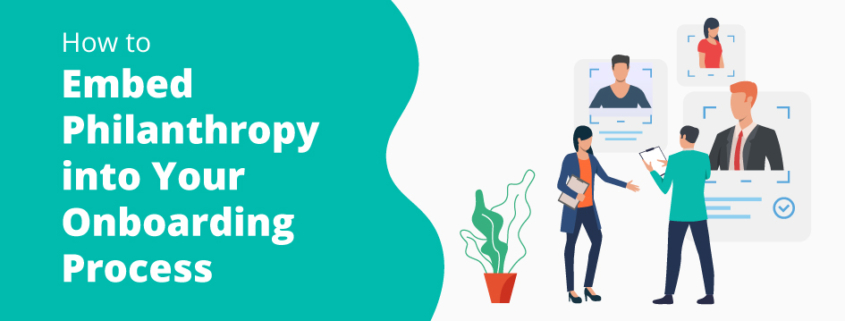How to Embed Philanthropy into Your Onboarding Process
70% of new hires can tell within the first week whether or not their new job is the right fit for them. The onboarding period is their first impression of your business, and it’s critical to their long-term success that they get off to a good start.
Your corporate social responsibility (CSR) program and philanthropic efforts are important facets of your overall employee engagement strategy, so why not incorporate them into your onboarding process and introduce new hires right away? Highlighting philanthropy during onboarding will make a great first impression during that critical period and improve the likelihood that they remain engaged and satisfied with their role.
Read on to learn more about intentionally embedding your philanthropy into your onboarding schedule to engage new employees.
Include your corporate philanthropy goals in their first-week information
Highlighting philanthropy during onboarding has two important outcomes. First, you demonstrate your business’s resolve and prove that your CSR work is not just lip service, and second, you give new employees the chance to get involved as soon as possible. As employees attend new-hire meetings and gain access to different software suites, make sure that your philanthropy program is included as mission-critical—not an afterthought.
In your onboarding schedule, set a dedicated time for a human resources staff member or CSR specialist to sit down with new hires and explain how your business’s philanthropy strategy works. You might include:
- Your business’s history of philanthropy, the causes you’ve supported most, and the impact of your efforts over time
- Why philanthropy is so important to your business and how it plays into your overall strategy
- Why your business includes philanthropy in its benefits package for staff
- Different opportunities for getting involved, from matching gifts to volunteerism
- Steps to request donations, matching gifts, and volunteer grants
By including philanthropy in your new hire’s educational meetings, you demonstrate how firmly integrated it is into how your business is run. This is good for your new hire—allowing them to see your business’s values from the first day—as well as good for you, because philanthropic programs like workplace giving increase staff engagement and retention.
Your business’s software stack likely includes project management tools, communication options, HR software, and many others. If you leverage CSR software to manage your philanthropy programs, make sure to incorporate it into your onboarding training, too. If you don’t, consider investing! According to Uncommon Giving’s CSR software guide, these platforms help you engage employees, increase trust, and improve your brand’s reputation.
Encourage a volunteer day with a mentor in their first month
Once your new hire has been introduced to your business’s philanthropic goals, it’s time to give them the opportunity to engage in a more hands-on fashion. Your organization’s corporate volunteerism program provides the perfect way to showcase your values in action, while giving them a break from the office or computer during the stressful first-month period.
The first month of their tenure is important for learning your processes and getting to know their coworkers, so it can be valuable on multiple levels to encourage them to take a volunteer day early on. First, it shows that your company really does want its employees to use those days. Second, it provides a great opportunity for them to connect with a more senior staffer, whether that’s an assigned mentor, their manager, or just someone who cares about the same cause that they do. If your team is geographically dispersed, it can also be a helpful way to encourage them to make an in-person connection with someone who is located nearby.
This opportunity will also show your new hire how your corporate giving culture works in action. Don’t forget to tell them about any additional resources, like volunteer grants, that their nonprofit of choice might be eligible for after their day out!
Highlight your corporate philanthropy priorities regularly
In their first week, new hires learn about your corporate philanthropy programs. In their first month, they participate in a hands-on way. But what about the rest of their first year?
Instead of relying on them remembering everything that was covered in their orientation, create regular checkpoints and reminders to share philanthropic opportunities with your whole staff. This might look like:
- Incorporating your efforts into your ongoing staff upskilling and training efforts. Ask your HR or corporate philanthropy departments to measure what parts of your strategy are most frequently used and which receive less attention. Highlight the less-popular options in training plans, or, if you find that your staff aren’t interested in that particular option, consider replacing it with something more aligned with their interests and values.
- Planning a matching gift drive for the end of your fiscal year. Your organization’s matching gift program is a great way for staff to support their favorite nonprofits, but they may not be aware that they have to submit their matching gift requests within a certain amount of time. As you approach the end of the eligibility period, whether that’s your fiscal year or the calendar year, highlight this program publicly and remind staff to submit requests.
- Creating an annual report describing your business’s corporate philanthropy efforts over the past year. Highlight the nonprofits your staff volunteered for, which causes you donated the most to, and your programs’ impact. Show your staff where their efforts went, remind them of the opportunities they have for contributing, and build excitement for next year.
Keeping your corporate philanthropy efforts front and center throughout the year will build your organization’s culture of giving, keep employees engaged, and continue to support the communities and nonprofits that your philanthropy serves.
With these tips, you can improve your bottom line and boost employee retention by embedding your corporate philanthropy directly into your onboarding process. If you remain consistent and focus on what resonates most with your employees, you’ll see participation continue to grow.


